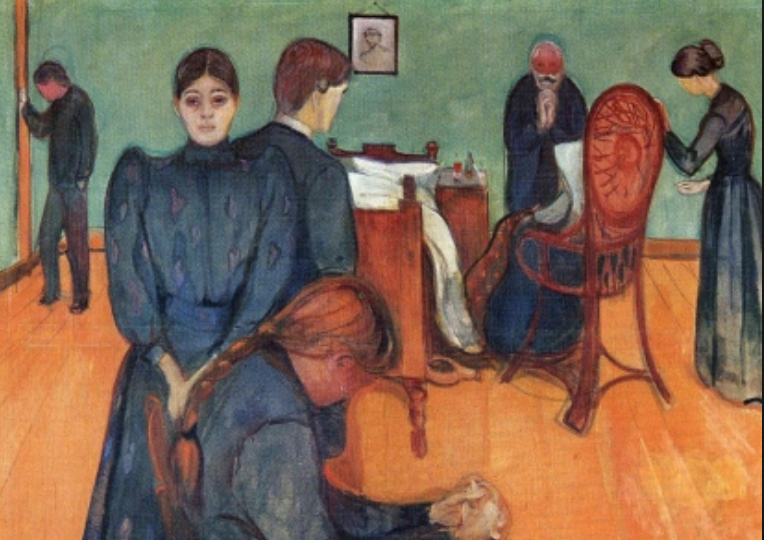I’m going to show you contrasting end of life sick beds. I’m hoping these images will help you think about your end-of-life moment more realistically.
The painting Death in the Sickroom, by Edvard Munch has the level of gravitas many of us imagine at our deathbeds.

Everyone is very passive, which suggests heavy emotion. They appear solitary, as though deeply caught up in the struggle with their internal thoughts over the dying person, in this case a young girl. The stillness also emphasises the moment’s significance.
Everyone in the room is clearly very sad; the man in the corner is turned towards the wall to hide his grief, the woman at the front of the painting has dropped her head, maybe in anguish, maybe in silent prayer.
This is how we tend to think of death, with a static context that allows deep feelings.
Now, let’s talk about CPR (cardiopulmonary resuscitation), one of the wonders of modern medicine.
It’s good to know that so many of us are training to help deliver CPR in emergencies in the community, such as the near death by drowning of Cassandra, who was saved by strangers who knew how to administer CPR. I’ll share more of her story another day.
When we’re trained to do manual heart compressions, today’s idea is usually to work on keeping blood flowing through the body, but particularly the brain, until paramedics can arrive with a defibrillator to give the heart electric shocks to start it again.
In a busy hospital, the CPR team, with its defibrillator, is on alert and ready to respond to a code to go to any part of the hospital and start this revival. This is because hospitals have seriously ill people in them who’ve just come out of surgery and so are at increased risk of a cardiac arrest.
If CPR involves a person who is otherwise fit, strong and healthy, their chances of surviving the incident that led their heart to stop beating can be good. Research suggests that 10-20% of all people who get CPR will survive and recover enough to leave the hospital – although this figure goes down if you look at how well they are doing three months later.
But what if the same thing happens to a 90-year-old who has had chronic heart disease for the last 10 years? When this person has CPR, the chances of living after that cardiac arrest, or of living for at least a year after that, are likely to be very low. You can’t say for sure but let’s imagine all the other medical information about that person points to a limited future.
For chronically ill elderly patients in this situation, studies show a less than five per cent chance of surviving long enough to leave the hospital after receiving CPR.
In the video I’ve embedded, watch the dedicated team from Chicago Hospital showing us CPR in a hospital, on a dummy. It’s heroic and dramatic and worth doing if you are likely to survive and leave hospital, fit and well.
But notice the chaos. And realise that if it happens in real life there’s more extreme stress involved for everyone because there is much more at risk. It’s not a situation that family members can easily be part of. While they might assert their rights to be there, they’re more likely to be shaking and standing back, if not right outside the room.
So now ask yourself a question. If you are very frail and know that your chances of surviving such CPR are low, or if you have a condition that would lead you back to another attempt to resuscitate you a little later, and then again and then again, is this frantic scenario what you want, the way you want to die?
If I was as strong and fit as I am now, I’d want the CPR. But if I’m not, I hope I’m brave enough to ask medical teams for honest assessments of my frailty score, to indicate my likelihood of surviving well once I leave hospital. If the scenario is hopeless, I hope I’m brave enough to forgo the CPR and to ask my family into the room instead.
Some of us would rather die trying. Others would prefer something more like the quiet reflection of the Edvard Munch painting – although a death from cardiac arrest won’t quite match the Munch painting either. But that’s also a story for another day.
For more about CPR in the elderly, go to: http:// https://dailycaring.com/the-reality-of-cpr-for-seniors-get-the-facts/
For more about advance care directives, see:https://good-grief.com.au/lets-talk-about-it/
